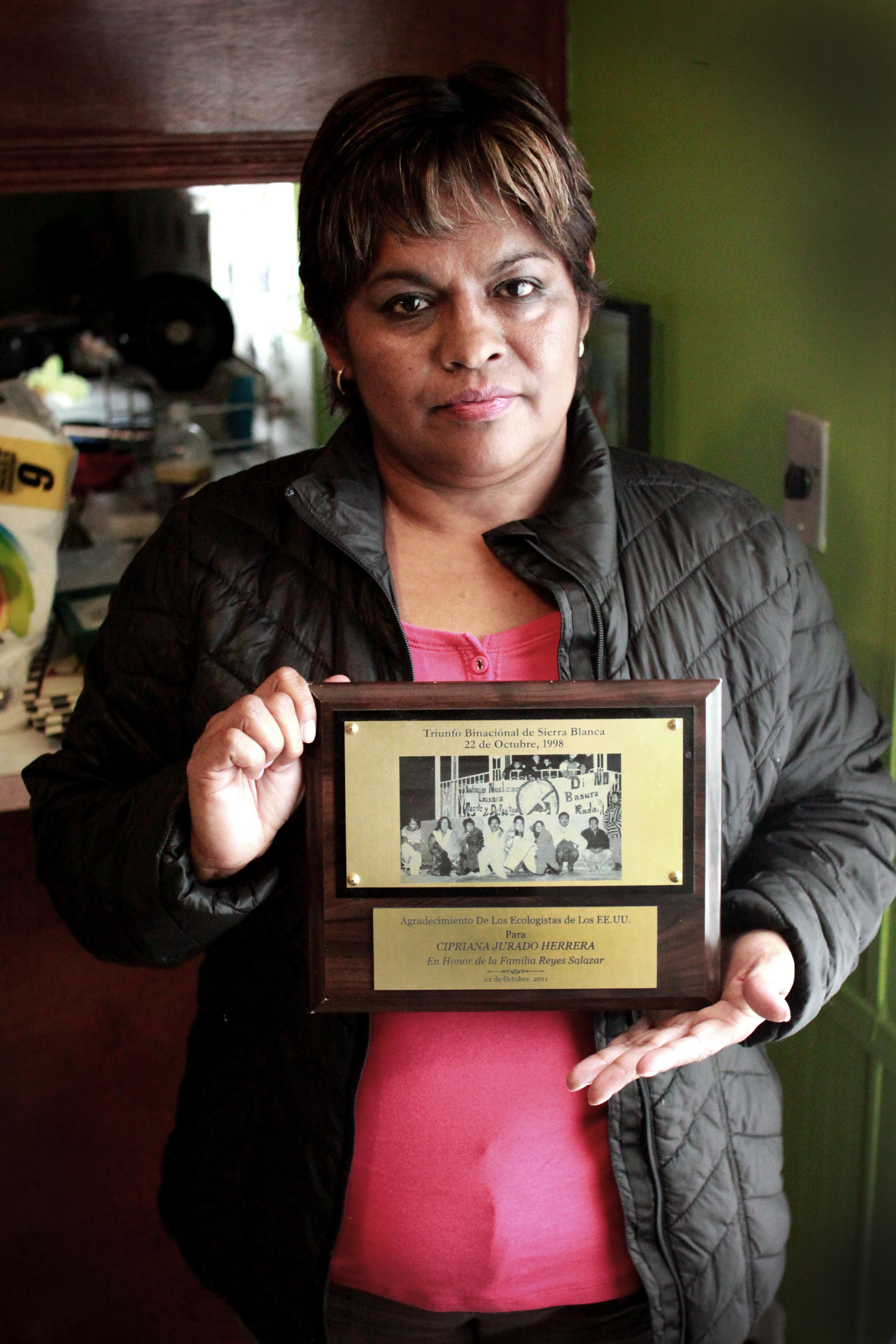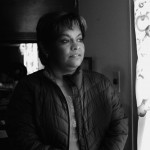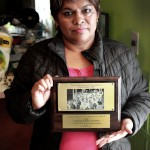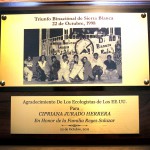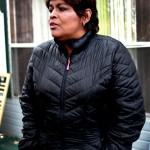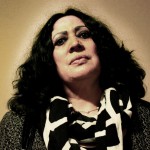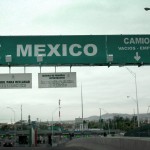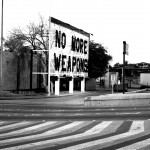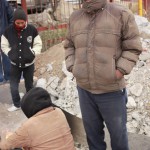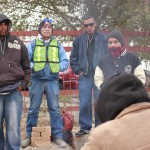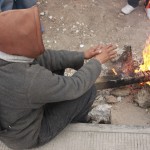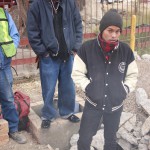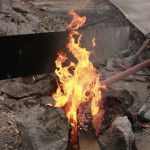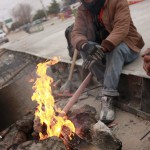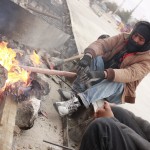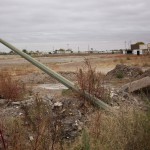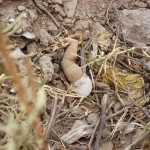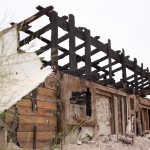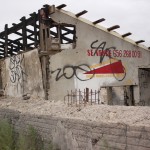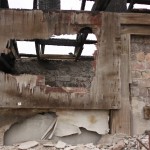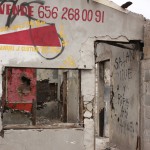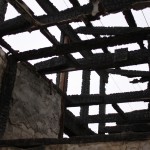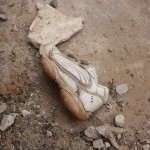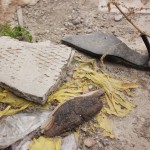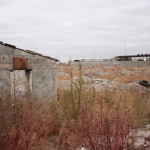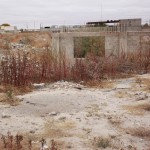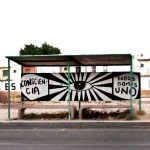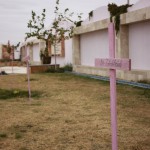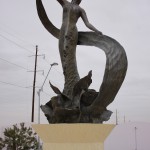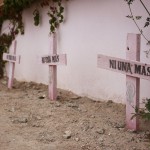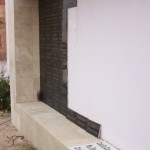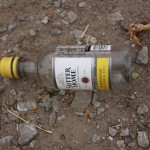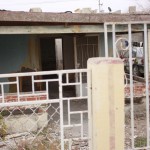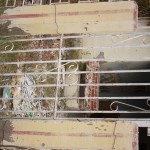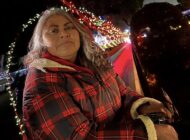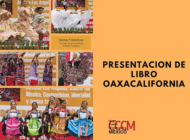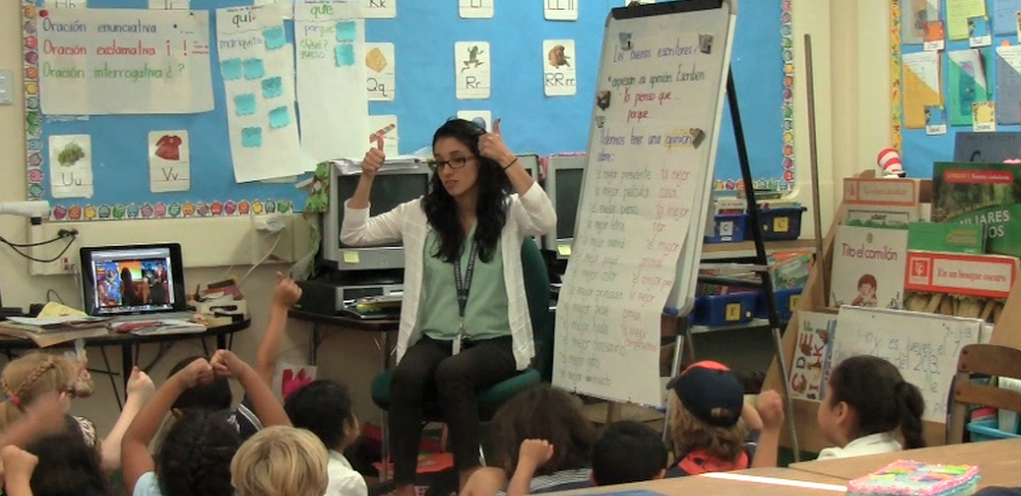Video by MUNA ADEM
By LUIS RIVAS
EL NUEVO SOL
When Muna and I were told that there might be an opportunity to interview activists from Ciudad Juárez who managed to flee from the violence, repression and death threats, the first thought that came to my mind was, “We need to go to Juárez.”
We read that it was one of the world’s most deadliest places outside of war-torn regions—and yet families continue to call that place home. People, but mainly women, continue to work in the highly exploitative and infamous maquiladoras (transnational manufacturing plants in free-trade zones).
Muna wanted to capture it all on film. I wanted to take photos and write the story.
These workers continue to get up each morning, go to work, come home, cook, eat, clean, raise children, briefly escaping it all with treasured sleep— all courageously so, while the city devours its own through sporadic drug-cartel violence, random viciousness and the methodological police and military killings.
But I am not courageous. I am not brave. I am reckless. I care very little for my own wellbeing. But, I figured, I could use that to my advantage. I can transform this recklessness into initiative to go into a potentially dangerous situation and bring more attention to the monstrous ramifications that free trade, unregulated capitalism and the maquiladora industry has wrought to Ciudad Juárez.
So we agreed to do it. Two activists agreed to meet with us. And we told them that we were going into Ciudad Juárez, they simple said, “Just get out before night falls.”
***
Authorized Kidnapping

Cipriana Jurado Herrera, 49, has been living in Santa Fe, New Mexico, since 2011. As a well known labor and human rights activist, she had to flee Ciudad Juárez after being kidnapped by unidentified, plain-clothes men claiming to be federal agents. Luis Rivas / El Nuevo Sol.
Cipriana recalls being in the backseat of a car with black-tinted windows and without license plates. She is frantically dialing and calling her friends, fellow activists, for help.
The driver and the other men who say they are with the AFI (Agencia Federal de Investigación), the Mexican equivalent of the FBI, tell her to shut up, that she, Cipriana Jurado Herrera, is under arrest, and if she doesn’t knock it off, they’ll throw the phone away.
She asks where they are taking her. They say they are taking her to jail. But, she says, you are going the wrong way. The men know that. She knows the city, Ciudad Juárez, every road and maquiladora. She keeps thinking about her kids. She remembers talking with other activists about the kidnapping and torturing that is rampant in the city. She keeps thinking about her kids, but she doesn’t cry. It’s a problem she has had for years now. She can’t cry. Only worry.
And then it started to rain.
***
Era of free trade and the maquiladora
In 2008 Jurado Herrera was abducted by plain-clothes unidentified men who claimed to be Mexican federal police officers, and took her into custody. After contacting fellow activists and Mexican congressman Victor Quintana and bringing media attention, putting enough pressure on Ciudad Juárez’ authorities, she was released the next day.
What was the initial charge then? That Jurado Herrera took part in a protest back in 2005, an obvious attempt by law enforcement to legitimize a spoiled attempt at disappearing her.
Being a woman, let alone an activist, let alone a stubborn one at that, can be a death sentence in Ciudad Juárez. Eventually, Jurado Herrera had to flee the country and was granted political asylum in the U.S. in 2011. Currently she resides in Santa Fe, New Mexico.
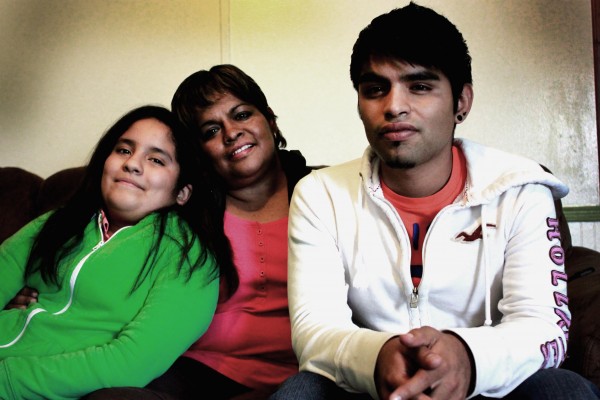
(From left to right) Isabel, daughter of Cipriana Jurado Herrera and her son Victor Daniel have been living in Santa Fe, New Mexico, since 2011. Luis Rivas / El Nuevo Sol.
In 1965, at the end of the U.S.-Mexico Bracero program, which allowed Mexican agricultural workers, primarily men, to work in the U.S. seasonally, the Mexican government was faced with a new dilemma: what to do with all these unemployed workers that were coming back home?
That’s where the idea of the maquiladora program began, as a means to alleviate unemployment for the returning men.
Not only were women were easier to employ, control and abuse, they were also cheaper.
Prior to when the maquiladora industry took off, Jurado Herrera remembers, Juárez was a stark difference than it is today.
“Juárez was a city … well, practically it was more of a rancho,” she said. “… there weren’t a lot of sufficient places to live. In that time people just took over land in the neighborhoods and brought their family to live with them and so that’s what we did … There was no water, light, pavement.”

TE Connectivity is one of more than 300 maquiladoras in Ciudad Juárez. On Nov. 22, 2013, several construction workers waited in front of the maquiladora for their paychecks. Luis Rivas / El Nuevo Sol.
According to REDCO, El Paso Regional Economic Development Corporation, there are more than 330 maquiladoras, including more than 70 Fortune 500 companies, operating in Ciudad Juárez which employ more than 178,900 workers as of April 2012.
Due to lax governmental regulations and restrictions, such as zero import duties against components used in maquiladora manufacturing, tax breaks, tariff-free, low pay and strict policies against a unionized workforce, Ciudad Juárez and similar places have become a beacon of promised prosperity and high-profit for multinational companies looking for the most optimal, deregulated areas for setting up shop.
Professor of Law at University of Arizona, David A. Gantz, acknowledges that the maquiladora industry in the U.S.-Mexico border area has created a couple of millions jobs approximately over the last 20 years.
“I think if you assume that the objective of the Mexican government with this program has been to create investment and jobs and [expertise], then it’s been generally quite successful,” Gantz said.
Currently, Mexico’s new president Enrique Peña Nieto has proposed to raise the few existing taxes on maquiladoras and lift a tax-exemption on goods imported for maquiladora assembly, according to an article published in the El Paso Times.
Many, but especially the maquiladora industry, are protesting this tax reform saying that business and jobs are at stake. Gantz said it’s hard to predict what exactly will happen.
“If you’re in business and you’re being threaten to pay more taxes, you’re seeing the impact as being very negative and dire, maybe even some cases even threatened to move, certainly some of the electronics companies did that 10 years ago,” he said.
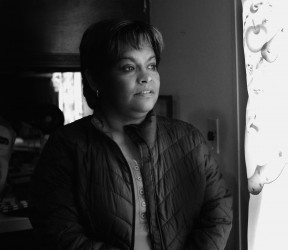
Cipriana Jurado Herrera, 49, has been living in Santa Fe, New Mexico, since 2011. As a well known labor and human rights activist, she had to flee Ciudad Juárez after being kidnapped by unidentified, plain-clothes men claiming to be federal agents. Luis Rivas / El Nuevo Sol.
When talking about maquiladoras, violence, deaths, the femicides, political corruption, and issue of poor infrastructure inevitably come up.
“There’s all sorts of problems,” he said. “Can you blame those on the maquilas? Indirectly, it’s part of a process of industrialization which began heavily back in the 1980s and pretty much continues because there don’t seem to be a lot of other ways of bringing about economic development…”
But not everyone has been pleased with this development.
Jurado Herrera, like many other people, but predominantly women, began working in the maquiladoras only to find low-pay, deplorable working conditions, harassment and repression by supervisors.
Grandmother Cipriana
Jurado Herrera began working the maquiladoras at the age of 13.
Her activism began at an early age when she was just a little girl, living with her grandmother, who she was named after, in the city of Jimenez in the Mexican state of Chihuahua.
Grandmother Cipriana was a local curandera, an elder healer of the community that utilizes indigenous spiritual practices, and a member of the Communist Party of Mexico. Both her and other members of the family were involved in the agrarian reform movement of ejidos, which were communal lands protected under the post-revolutionary Mexican constitution.
Although still in existence, ejidos declined in their once-revolutionary spirit and took the form of capitalist farms with more market-friendly structures. In the early 1990s, ejidos all but ended due to the neoliberal influences of President Carlos Salinas de Gortari and the controversial North American Free Trade Agreement, an economic agreement between Canada, United States and Mexico, that sought to open up country markets to international trade.
Toward the end of the 70s and early 80s, Jurado Herrera and her family helped formed the Ejido Héroes de la Revolución (Commune Heroes of the Revolution) in Jiménez, which was a commune where people grew their own food, shared it amongst each other and built their own houses.
“The construction style of the houses was Cuban style,” she said. “That is, the land was communal. Everyone farmed, worked the land and shared everything.”
Although she was a little girl, this as well as her exposure to church-based community organizing would inevitably influence her for all of her life to come as an activist. Jurado Herrera’s past plays a fundamental role in her present life and activism.
“Well, I come from the countryside,” Jurado Herrera said. “I was in that struggle without wanting it. It was destiny, the work that my grandmother and uncle. And then when the poor people of Chihuahua started to organize and went to Juarez, and went to the border because being close to the border, you can make a movement more bi-national.”
The lost generation
In 2010, the killings in Juarez were 3,111 according to the official media tally, although a March 2011 report the Chihuahua State Attorney General tallied it at 3,951, according to Molly Molloy, a research librarian at New Mexico University, Las Cruces. Molloy has been tracking the killings in Juárez and maintains an email listserve “Frontera List”—with about 1,000 subscribers.
In spite of this decline, Juárez still remains of the world’s deadliest places outside of war-torn regions.
“It was like going out to the street and immediately finding people firing at each other in all areas of the city,” Jurado Herrera remembers. “In 2007 when this kind of violence in Juárez was common, where people would get killed all the time, (it was) several years with this city having the most killings than other places in war.”
Jurado Herrera recommended we talk with another activist from Ciudad Juárez, a former school teacher whose student became a femicide statistic, whose son-in-law was killed and eventually whose brother was killed—just six months ago.
But, she says, we can’t go to her home. Security reasons. Of course, I say. I’m doing most of the talking since Muna can’t speak Spanish.
She recommends we speak to her because, she says, one of the saddest things is the children of these victims, many of which are now orphans.
Maquiladoras, families and children
When I asked where we can go to get the interview, Marisela Ortiz, a transplant Ciudad Juárez resident now living Texas for the last three years, responds: “Your motel room will be fine.”
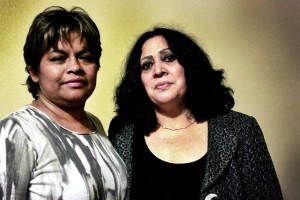
Cipriana Jurado Herrera (left) and Marisela Ortiz (right) are both human rights activists from Ciudad Juárez who had to flee after receiving death threats for their work around femicides, police and military repression and corruption. Luis Rivas / El Nuevo Sol.
Everything is being coordinated through Jurado Herrera: time, location, duration. We tell Jurado Herrera who relays the information to Ortiz that we’ll be in El Paso by 5 p.m. Jurado Herrera texts her the address and room number to our motel. Ortiz texts back that she’ll be there by 6 p.m.
Ortiz was a high school teacher in Juárez for three years when one of her students, Lilia Alejandra Andrade García, disappeared and was eventually found to have been killed in February 2001. Ortiz supported the family in their search for their daughter, and continued to demand justice for the García family. Ortiz went on to help start the organization Nuestras Hijas de Regreso a Casa (Our Daughters Back Home), a non-governmental organization that works against the femicides.
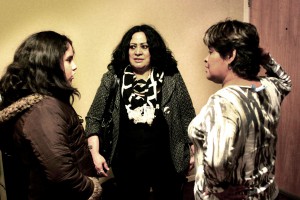
(From left to right) Isabel (daughter of Cipriana Jurado Herrera), Marisela Ortiz and Cipriana Jurado Herrera stand in a motel room in El Paso, Texas, on Nov. 21, 2013, talking about Ciudad Juárez. Luis Rivas / El Nuevo Sol.
During her time as a teacher in Juárez, she would often visit the families at their home, primarily due to the busy maquiladora work schedule of many of the parents, often time single mothers.
“It was common for me to visit them at their homes because the mothers didn’t have time to get involved with their children at school, to have meetings with their teachers,” Ortiz said. “So I had to go to their homes on their off days.”
Ortiz remembered seeing how poor these communities were, their houses, their socioeconomic standing. The mothers had to work most of the day—many never really saw their children grow up, she said. They had to be at the maquiladoras most of the time. It was a matter of survival, adversely affecting home life.
Although drug-cartel violence is an undeniable factor in the killings in Juárez, some of the longer-lasting effects of violence are much more tragic, as they are seen in the faces of the orphaned and traumatized children. This is perhaps the worst kind of violence.
“The children grow up alone,” Ortiz said. “They don’t grow up under the guidance of a father or a mother. They don’t have anyone that worries about them. For me, it brought me a lot of sadness to see boys and girls in unhealthy relationships with severe insecurities, with low self-esteems.”
And many, Ortiz said, are not adopted out of fear that they are somehow tainted or may bring further violence to their new family. Like a curse.
She would notice her students acting like this, call one into the office and when she would ask what was wrong, looking at her face, touching their hands, the students would break down in tears.
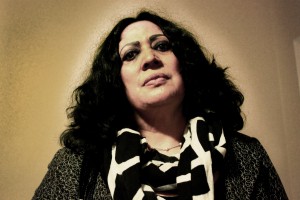
Marisela Ortiz is a human rights activist from Ciudad Juárez who had to feel after receiving death threats because of her work against the femicides and other human rights abuses in the city. Both her son-in-law was and brother were killed in retaliation to her activism, she said. Luis Rivas / El Nuevo Sol.
“Many times these problems would be exacerbated by the fact that women, economically independent, working in the maquiladoras would start seeing a partner that wasn’t stable who would come to live in their home, where her kids were … and in many occasions … the partners raped the girls,” she said. “Because the mother wasn’t present, because they had different shifts.”
With the maquiladoras came job benefits, sure, but also negative effects to the family. Long work shifts which alienated parents from their children, rampant cases of sexual abuse from romantic partners living at the home, killings, disappearances and systemic traumas: all have chipped away at the humanity of the inhabitants of Juárez.
***
Eventually, we finish with the interview and Ortiz says goodbye and leaves. Muna and I stay up late editing our stories, looking through the footage: photos, audio, notes. She goes outside to smoke. I type a few paragraphs of quotes, research statistics online for Ortiz’ and Jurado Herrera’s story.
Muna comes rushing in from the blasting El Paso cold.
“Luis! There are two men right outside of the motel room sitting in a car,” she said. “Just sitting there, waiving at me.”
Our minds begin racing. Are they following us? Did they follow us from Santa Few, New Mexico, from when we interviewed Jurado Herrera?
Images from Charles Bowden’s book on Ciudad Juárez, “Murder City,” flash through my mind; I am begin decapitated, my extremities are being hacked off by perfectly heartless sicarios, assassins—probably cops or soldiers.
I text a friend back home, “Just a heads up. Two guys. One Latino. Another white-looking guy. In a green car in front of our motel room.”
That way there’s proof. Just in case.
Muna and I peek through the peephole. The men are still in the car. They remain there for a few minutes. Eventually, they get up and walk next door, presumably into a room.
Reluctantly and anxious with panic, we somehow manage to go to sleep.
In the morning we wake up and cross into Juárez.
We visit several of the maquiladoras, which are not hard to find. They range from being the size entire city blocks to smaller buildings. The maquiladoras have security guards stationed near the entrance. Recklessly, we get out of the car and walk around the city with our cameras. People are giving us strange looks, almost in disbelief or annoyance. Apparently, it’s an unwritten and well-known rule that as a journalist you shouldn’t seek attention. Especially journalists from outside of the city.
But Muna and I continue.
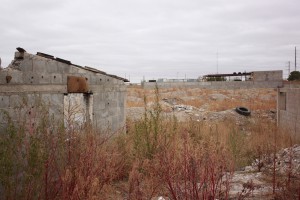
In Ciudad Juárez, in between the hundreds of maquiladoras and neighborhoods, are abandoned houses and flat fields with riddled with trash.
We take photos and video of the maquiladoras, the flat fields of dying cotton and abandoned and burned houses, construction workers on break, the abject poverty of the colonias, the neighborhoods—where houses, missing doors, walls and parts of the roof look abandoned but are inhabited somehow.
The houses are not houses. The maquiladoras are not maquiladoras. Ciudad Juárez is not a city. No. Everything here is a laboratory, an experiment of unregulated capitalism, of political corruption, of multi-faceted violence that comes from the drug-cartels, the police, the military, of a free trade agreement that promised economic stability, prosperity and security.
***
The signing of NAFTA in 1994 and the militarization of Juarez in 2008 in an effort to combat the drug cartel violence by former Mexican President Felipe Calderon, all had direct affects in the killings and femicides, according to Ortiz.
“With the free trade agreement, and the implementation of the maquiladora industry, brought many women from different parts of Mexico, some without money, without family, which increases their vulnerability,” she said. “And in a sexist system, the man tries to dominate a woman, and if she doesn’t allow it, well, she gets beaten, she gets mistreated, and ultimately she may get killed.”
Ortiz explains the gruesome nature of the killings as being sacrificial rituals, perhaps of initiations, for drug cartels. At first, women were targeted but then it moved to younger women in their 20s and eventually to girls, ages 12 and younger. It was a competitive cycle of violence, with each new participant outcompeting the previous one—but with the Mexican military, uniformed or not, usually always winning.
The future of Ciudad Juárez
It is said that people continue to make a living in Juárez. Children still go to school. Boyfriends and girlfriends manage to exist. Parents continue to work at the maquiladoras. People still wait on the corner for ruteras, the buses, that seldom come. The chilling temperature in Juárez acts as a warning sign for its inhabitants: don’t come outside—stay in.
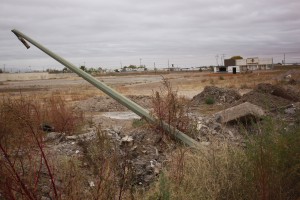
In Ciudad Juárez, in between the hundreds of maquiladoras and neighborhoods, are abandoned houses and flat fields with riddled with trash. Luis Rivas / El Nuevo Sol.
Juárez has become a living cemetery, a functioning mausoleum, an experiment of free-trade zones that promised the governments of Mexico and the U.S. financial security and stability amid a globalizing economy.
For some, fixing the problem of places such as Juárez is a matter of changing national policy, questioning the role of under-regulated capitalism, neoliberalism—the very nature of the maquiladoras.
But for others, the problem is merely an issue of ensuring that people are held accountable, in all sectors of society: from the very top of government to the bottom of civic society.
“If every president, if every governor, if every mayor, if every employer, if every citizen, if every professional did what they were in charge of doing, things would be a lot better,” she said.
She has hope. Hope in the government and in these institutions. Somehow in some way, things can change for the better, and focus should be placed on the next generation of children, to ensure that they don’t continue this legacy of violence. Ortiz is a better person than me—for so many more reasons that I care to get into. But, primarily, because she has hope. I do not.
In the end, the fate of Juárez rests in the hands of not only Ortiz and Jurado Herrera but of all the others who have decided to act boldly with hope and determination. What happens next is yet to be written, and that world, a future Juárez, a Juárez that is yet to be, is inhabitable by pessimists such as your author. The future world is made for optimists.
“But that’s why we are working. Hope is what moves us. We want everything to change. We need to make things change,” she said.

Leaving Ciudad Juárez, we cross one of the bridges that lead into El Paso, Texas, on Nov. 22, 2013. Luis Rivas / El Nuevo Sol.
***
For more information on how to get involved, go the Nuestras Hijas de Regreseo a Casa website or Mexicanos en Exilio.
Tags: Cipriana Jurado Ciudad Juárez CSUN El Nuevo Sol Feminicidio maquiladoras Marisela Ortiz protest social justice union workers






